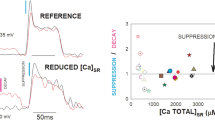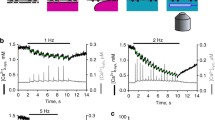Abstract
In the presynaptic nerve terminals of the bullfrog sympathetic ganglia, repetitive nerve firing evokes [Ca2+] transients that decay monotonically. An algorithm based on an eigenfunction expansion method was used for fitting these [Ca2+] decay records. The data were fitted by a linear combination of two to four exponential functions. A mathematical model with three intraterminal membrane-bound compartments was developed to describe the observed Ca2+ decay. The model predicts that the number of exponential functions, n, contained in the decay data corresponds to n − 1 intraterminal Ca2+ stores that release Ca2+ during the decay. Moreover, when a store stops releasing or starts to release Ca2+, the decay data should be fitted by functions that contain one less exponential component for the former and one more for the latter than do the fitting functions for control data. Because of the current lack of a parameter by which quantitative comparisons can be made between two decay processes when at least one of them contained more than one exponential components, we defined a parameter, the overall rate (OR) of decay, as the trace of the coefficient matrix of the differential equation systems of our model. We used the mathematical properties of the model and of the OR to interpret effects of ryanodine and of a mitochondria uncoupler on Ca2+ decay. The results of the analysis were consistent with the ryanodine-sensitive store, mitochondria, and another, yet unidentified store release Ca2+ into the cytosol of the presynaptic nerve terminals during Ca2+ decay. Our model also predicts that mitochondrial Ca2+ buffering accounted for more than 86% of all the flux rates across various membranes combined and that there are type 3 and type 1 and/or type 2 ryanodine receptors in these terminals.
Similar content being viewed by others
References
Ashley RH (1989) Activation and conductance properties of ryanodine-sensitive calcium channels from brain microsomal membranes incorporated into planar lipid bilayers. J. Membrane Biol. 111:179-189.
Bezprozvanny I, Watras J, Ehrlich BE (1991) Bell-shaped calcium-response curves of Ins(1, 4, 5)P3-and calcium-gated channels from endoplasmic reticulum of cerebellum. Nature 351:751-754.
Dodd J, Horn JP (1983) A reclassification of Band C Neurons in the ninth and tenth paravertebral sympathetic ganglia of the bullfrog. J. Physiol. (Lond.) 334:255-269.
Fabiato A (1985) Time and calcium dependence of activation and inactivation of calcium-induced release of calcium from the sarcoplasmic reticulum of a skinned canine cardiac Purkinje cell. J. Gen. Physiol. 85:247-289.
Friel DD (1995) [Ca2+] oscillations in sympathetic neurons: An experimental test of a theoretical model. Biophys. J. 68:1752-1766.
Gunter KK, Gunter TE (1994) Transport of calcium by mitochondria. J. Bioenerg. Biomembr. 26:471-485.
Henzi V, MacDermott AB (1991) Characteristics and function of Ca2+-and inositol 1,4,5-triphosphate-releasable stores of Ca2+ in neurons. Neurosci. 46:251-273.
Lysakowski A, Figueras H, Price SD, Peng Y-Y (1999) Dense-cored vesicles, smooth endoplasmic reticulum and mitochondria are closely associated with non-specialized parts of plasma membrane of nerve terminals: Implications on exocytosis and calcium buffering by intraterminal organelles. J. Comp. Neurol. 403:378-390.
McPherson PS, Kim Y-K, Valdivia H, Knudson M, Takekura H, Franzini-Armstrong C, Coronado R, Campbell KP (1991) The brain ryanodine receptor: A caffeine-sensitive calcium release channel. Neuron 7:17-25.
Miller RJ (1991) The control of neuronal Ca2+ homeostasis. Prog. Neurobiol. 37:255-285.
Palade P, Dettbarn C, Barbara A, Volpe P (1989) Pharmacologic differentiation between inositol-1,4,5-trisphosphate-induced Ca2+ release and Ca2+-or caffeine-induced Ca2+ release from intracellular membrane systems. Molecular Pharm. 36:673-680.
Peng YY (1996) Ryanodine-sensitive component of calcium transients evoked by nerve firing at presynaptic nerve terminals. J. Neurosci. 16:6703-6712.
Peng YY (1998) Effects of mitochondrion on calcium transients at intact presynaptic terminals depend on frequency of nerve firing. J. Neurophysiol. 80:186-195.
Peng YY, Horn JP (1991) Continuous repetitive stimuli are more effective than bursts for evoking CHRH release in bullfrog sympathetic ganglia. J. Neurosci. 11:85-95.
Peng YY, Wang KS (1998) Three intracellular compartments release calcium during calcium decay after repetitive firing of intact presynaptic nerve terminals. Soc. Neurosci. Abstracts 24:227.9.
Peng YY, Zucker RS (1993) Release of LHRH is linearly related to the time integral of presynaptic Ca2+ elevation above a threshold level in bullfrog sympathetic ganglia. Neuron 10:465-473.
Provencher SW (1976a) An eigenfunction expansion method for the analysis of exponential decay curves. J. Chem. Phys. 64:2772-2777.
Provencher SW (1976b) A Fourier method for the analysis of exponential decay curves. Biophys. J. 16:27-41.
Rizzuto R, Brini M, Murgia M, Pozzan T (1993) Microdomains with high Ca2+ close to IP3-sensitive channels that are sensed by neighboring mitochondria. Science 262:744-747.
Rousseau E, Smith JS, Meissner G (1987) Ryanodine modifies conductance and gating behavior of single Ca2+release channel. Am. J. Physiol. 253:C364-C368.
Author information
Authors and Affiliations
Rights and permissions
About this article
Cite this article
Peng, YY., Wang, KS. A Four-Compartment Model for Ca2+ Dynamics: An Interpretation of Ca2+ Decay after Repetitive Firing of Intact Nerve Terminals. J Comput Neurosci 8, 275–298 (2000). https://doi.org/10.1023/A:1008954127682
Issue Date:
DOI: https://doi.org/10.1023/A:1008954127682




